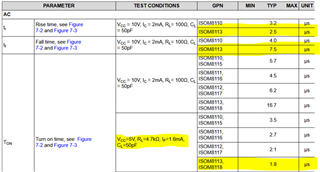Tool/software:
Hi,
Please could you provide some guidance on the Ton/Toff times:
1) How are these likely to vary with temperature - it's only listed at RTP.
2) Is there no Min/Max listed because it's circuit dependent? Is there anyway to approximate what this might be for our design? We have Vcc=3.3V, Rl=3.3k, If=1.5mA. CL is unknown but as it's connecting to an SN74LVC2G14DBVR which lists 4pF and we have a relatively short trace, we're assuming it's lower than 50pF.
Many thanks




